M.SM. – 82 years old – Diagnosis: dementia; presumptive Alzheimer’s disease – Autonomy: Needs motivation and direction to complete activities – Behavior: smiling – Communication: speech difficulties.
Within retirement homes, or services with long and medium term stays, CAP provides a support that is, in particular, well suited and diversified to the pathologies present at the end of life.
CAP offers a highly structured and codified methodology that is different from traditional therapies. This method allows the expression of another language, the language of drawing that relies on the experience of each individual. The process results in the mobilization of each patient’s potential which results in a feeling of wellness, both physical and mental.
In addition to these general effects, CAP engages each person with personalized attention that can serve as a basis for a sound psychological treatment. CAP is able to establish an effective protocol for daily living that is therapeutic and is adaptable for the needs of each individual resident.
Description of the CAP sessions
14 SESSIONS
- 2 reference sessions, one before and one after the sessions with graphic expression under musical induction
- 10 sessions of graphic expression under musical induction.
Under the supervision of Chantal Desmoulins:
- 1 assessment with residents
- 1 assessment with staff and management (no resident participation)
CONDITIONS
The sessions take place in the same room every Tuesday at 2 pm, with the same group of people, during the 13 weeks.
The selected room will provide the following conditions:
- ease of access
- remote location, to promote an atmosphere which is safe and confidential as well as secluded from the normal environment
- setting which can accommodate the number of participants for group work.
During the sessions, each resident is invited to draw freely while listening to music. Staff facilitation is at times implemented to stimulate the resident, in order to trigger movement, but is not involved in the selection of colors or the orientation of the sheet and gives no information about the offered music program. Following the graphic expression, residents are offered the opportunity to express their feelings regarding the session.
Given the cognitive deterioration, lack of temporality of the group at the beginning of the implementation and praxis limitations of the program participants, it was necessary to simplify the instructions into short steps, which were always the same, in order to help residents to find their way easily.
Too many instructions or explanations quickly overload the disorientated person. Materials used during the sessions were reduced to a bare minimum, in order to help everyone concentrate.
We are going to look to the M.SM’s CAP journey
The CAP sessions with M.SM are done in a group of 8 residents.
The Global Goals for Resident Participants
These CAP sessions aim to resolve the tensions between residents in their unit. By offering an open and safe environment- without the restriction imposed upon within a confined location – we seek to create an atmosphere among the residents that fosters union and group connection.
The Specific Goal defined for M.SM is: facilitate her integration within the group and the institution
Behavior of M.SM during the sessions:
She participates in the program two weeks after her admission in the unit. The struggle to adapt to her new environment has been difficult. Although she lived alone in her little town, she was active with her friends in the community.
The program provided her the opportunity, within a safe enclosed location, to be able to express her feelings about her illness, the challenges in her personal life as well as the ability to share important memories.
From the first sessions on, she needs to talk about the reality of the disease.
Reference session 1 without music
➛ CD1: “I need something that helps me to feel alive” she says “I’m old…I do not feel well here.” ➛ CD2: « The head, it’s not ok. You know, I am not well, it’s the truth… » She expresses a sense of fatalism and loneliness with a sense of regret of not having a daughter: « I have only boys, what do you want… »
➛ However, from the third session (CD2) on, she begins to adapt to the life unit. Her sons who say they have come to see her at her home, reinforces the reality of her new living situation. With this acceptance, she no longer expresses a desire to return to her previous home.
➛ She acknowledges the group as a witness to her emotions (CD4). « I feel bad, I cry »… (CD5). « I would only cry » (CD6). She is an active participant in the life of the unit. Caregivers have noticed that she sometimes supports others. Even though she is not feeling well physically, an improvement is seen in her speech and the continuity of her thought process.
➛ From the 8th session (CD7) on, she is no longer requesting help and is orientated to person, place and time. She is calm and interacts with the group. An example of her participation is her interest in reading what has been written in her notebook with an expression of curiosity and kindness. She is also communicating more with the other residents.
➛ During the 9th session (CD8), she expresses loneliness, suffering and grieving of her former life: « I am alone… how do my sons know that I cry every day?… I have nothing in my head, I can not draw today… » She cries, clings to her handkerchief.
➛ During the 10th session (CD9), she seems to forge new beliefs: « It’s fun, as when we went to school. I’m all alone. Fortunately I have neighbors. Otherwise I would become – her hand pointing her head meaning madness… Some are of my age. I even have a friend here. »
➛ On the last session – Reference session 2 without music – she bends the corner of the sheet where she is able to release her loneliness and concludes: « It’s OK, I’m not all alone, like that. And I cry. When one has seen someone else, it is a little better. I have seen many. » Her relaxed smiling attitude and her ability to ask for help, show that a milestone was reached after this session.
Observation sheet:
Her eyes are open most of the time. We observe many defense mechanisms in this person. However, she shows a profound receptivity to music and succeeds in relaxing on CD 3, 4 and 8.
Synthesis of the Space Test:
➛ In the pre-test, there is in the top-left area (zone of inhibition, repression, nostalgia) an additional and empty circle confirming her suffering and the sense of not being the master of her life anymore. The sheet, placed horizontally, seems to be a further confirmation. The fold of the sheet, well marked, and the place of the circles on the axes indicate, however, that this person is capable of expressing who they are assertively.
➛ In the post-test, this additional circle has disappeared. The 5 circles are encased with another circle, as if she had built a protective shell. The size of the circles is uniform. The sheet is now placed vertically reflecting a positive redirection of the self.
Synthesis of the Self-Assessment Questionnaire:
➛ The pre-test shows an expression of the self. She does not repress her feelings of unhappiness.
- A major scale of depression:
- To the item « I felt sad » the answer is « continuously »
- To the item « I had trouble concentrating » it is « often »
- To the item « I thought my life was a failure » it is « often »
- To the item « I was confident in the future » the answer is « never ».
➛ In the post-test, there is a marked improvement in all items of the mood scale, since she no longer answers using the ‘ongoing’ column.
- To the item « I felt sad », the answer is now « Sometimes »
- She even hesitated to answer « Never » – she made a cross then struck it out
- To the item « I struggled to concentrate », the answer is now « Sometimes »
- To the item « I thought my life was a failure », the answer now is « Never »
- To the item « I was confident in the future », the answer is now « Sometimes ».
Of all the participants, she is the only one with the most diversified answers.
Synthesis of her Drawings:
In her drawings, M.SM, often utilized the top left zone – a zone in which she placed an empty circle in the Space Test. This seems to indicate an attempt to forget the weight of painful and conflicting events of her past.
The sessions with CAP allowed her to revisit her distressing memories, without having to go through a painful process of consciously verbalizing the events.
M.SM draws cats throughout the series. Symbolically, they represent the repetitive patterns and habits gathered from her life (family, profession, social life) which are the source of hardship and suffering. One can follow the evolution of her cats over the drawings:
➛ CD1: narrowed cat with a black mustache (antennas) shows that she perceives things in terms of anxiety – old wounds she has repressed and can gently explore throughout the sessions with CAP.
➛ CD2: black cat, bristling, haggard, confirms the shocks she received throughout her life. The cat’s position, on the left, reflects the fact that the past is revisited subconsciously and indirectly to avoid too much suffering.
➛ CD3: The cat stands upright like a human and migrates to the area on the right. This movement illustrates her inner work in progress.
➛ CD4: We note the beginning of a smile on a red cat with blue eyes, still in the top left area which indicates an old secret wound is being accepted (the smile indicates an appeasement in progress). Another brown cat is drawn with the left hind paw black, as a wound. The resident symbolically reflects an emotional wound that could have been a handicap in her life. These images clarify how the process allows the individual to address the consequences which result of these emotional injuries.
➛ From the CD5 to CD10, she explores different aspects of herself. The theme of the drawing is more complex and there is a wider variety in the use of color. She writes more.
➛ Finally, in the Reference Drawing No. 2, we find the brown cat from CD4 again. This time, it has a beautiful colored mustache and the left hind paw is repaired. The tail has also been recovered, confirming the inner recovery of M.SM.
Synthesis of her Verbalizations
Observing the graph we observe the prevalence of pure emotional responses. Ms. Marcelle-Simone M. clearly expresses her emotions: « I’m sad… I’m alone. » She also clearly expresses her physical discomfort: « I have a headache… I’m really not fine. »
It is at the very end of the process that these responses evolve: « It’s OK, I’m not all alone, like that. When one has seen someone else, we feel a little better. I have seen many people today. »
The assessment of M.SM. :
She takes an irreverent tone, seeing all these cats: « Oh… I do not know, there is a cat! » and asks: « So, who made these drawings? » Another resident singles her out her and she starts laughing heartily.
During this assessment, M.SM. displays much resistance, which confirms our previous assumptions that in certain situations she is compelled to deal with them in an indirect manner. With this information, caregivers need to pay attention to allowing her to move at her own pace and to not rush her.
It is interesting to note that her resistance is perceived by another resident, France, who encourages her to let go: « But you will learn something! »
An interesting group dynamic begins to emerge. M.SM. starts listening and wonders: « And it was me who have done all this? » Always very active, France, looking carefully at the drawings, exclaims: « Oh, that’s great, you know! »
Gradually, M.SM. begins to reveal some memories of the animals she raised in her life. When the facilitators suggest that the drawings may be related to other hardships in her life, she contemplates the symbolism in her drawings representing the obstacles and confirms: “Oh yes…”
Herself, as well as the group, is captivated by the assessment and listens to each story as if it were a fairy tale. The stories illustrated through the drawings create an atmosphere where each of the residents feels connected to each other. Each of them discovers meaning to their personal story which is ‘magical’ to them. At the conclusion of Ms. M.SM.. assessment, it is France who in amazement to all that has been revealed, concludes: « Ah this, I got it! »
At the end of the assessment, M.SM. remains silent. When leaving the room, she takes the hands of one of the staff, stares into her eyes, and with a smile and misty eyes, breathes a deep sigh.
CONCLUSION
The personal goal set for Ms. M.SM. has been reached. She has utilized the CAP process to act as a forum where she was able to abandon the mourning of her former lifestyle and incorporate a new one.
Following her recent admittance in the retirement home, she was in a state of shock and denial. Now she has adapted to the routine of the care ward, where she lives in harmony with others.

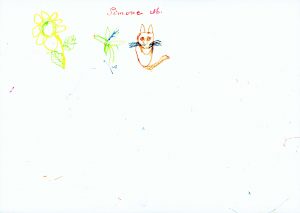
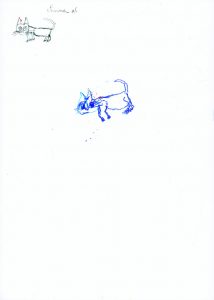

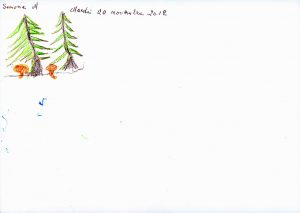



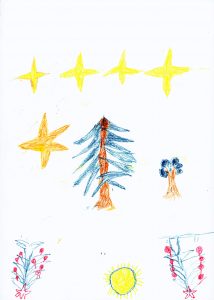

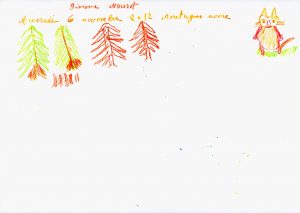
Les commentaires sont fermés